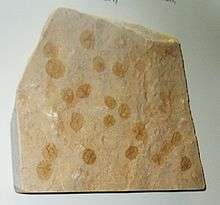Nimbia occlusa
| Nimbia occlusa Temporal range: Cryogenian-Cambrian | |
|---|---|
 | |
| Scientific classification | |
| Kingdom: | incertae sedis |
| Genus: | Nimbia |
| Species: | N. occlusa Fedonkin 1980 |
Nimbia occlusa is a form of Ediacaran fossil shaped like a circular or oval disk, with a thick rim around the margin. Within the rim the fossil is usually flat, but may have a central nipple or dimple. These fossils were generally believed to be those of cnidarians, but they have since been reinterpreted as structures made by microbial colonies (Grazhdankin, see Ediacaran biota for references and discussion.). They can reach up to 6 cm in diameter, with a centimeter-thick rim. Some fossils are distorted.
Nimbia occurs in numerous locations across a large range of time, which lends weight to theories that the fossil does not represent a single animal species. It occurs in the Twitya formation in the Mackenzie Mountains in Canada dated at 610 million years ago, near the end of the Marinoan glaciation, and in 770 million years ago rocks in Kazakhstan.[1] Aspidella also appears in these areas. Morania and Beltina carbonaceous film fossils in the Twitya formation are not considered to be animals. Nimbia-like fossils have also been found in the Cambrian period.
See also
References
- ↑ Meert, J. G.; Gibsher, A. S.; Levashova, N. M.; Grice, W. C.; Kamenov, G. D.; Rybanin, A. (2010). "Glaciation and ~770 Ma Ediacara (?) Fossils from the Lesser Karatau Microcontinent, Kazakhstan". Gondwana Research. 19 (4): 867–880. doi:10.1016/j.gr.2010.11.008.
- Fedonkin, MA (1980). "Novye Predstaviteli Dokembriyskikh Kishechnopolostnykh na Severe Russkoy Platformy (New Precambrian Coelenterata in the North of the Russian Platform)". Paleontologicheskiy Zhurnal (in Russian). 2: 7–15.